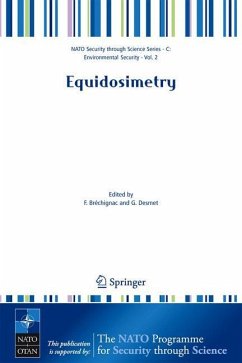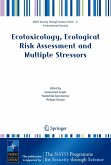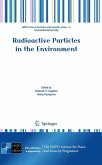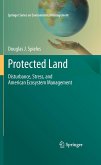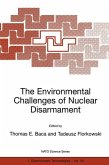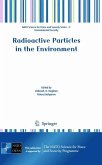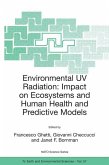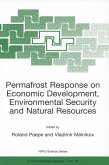F. Brechignac / G. Desmet (eds.)Ecological Standardization and Equidosimetry for Radioecology and Environmental Ecology
Equidosimetry
Ecological Standardization and Equidosimetry for Radioecology and Environmental Ecology
Herausgegeben:Bréchignac, F.; Desmet, G.
F. Brechignac / G. Desmet (eds.)Ecological Standardization and Equidosimetry for Radioecology and Environmental Ecology
Equidosimetry
Ecological Standardization and Equidosimetry for Radioecology and Environmental Ecology
Herausgegeben:Bréchignac, F.; Desmet, G.
- Gebundenes Buch
- Merkliste
- Auf die Merkliste
- Bewerten Bewerten
- Teilen
- Produkt teilen
- Produkterinnerung
- Produkterinnerung
Considerable experience with radioecological and related ecological research on terrestrial and aquatic ecosystems has been achieved, especially after the Chernobyl accident. The combined effects of the radiation, chemical and biological factors, after a contamination of the environment and during its remediation have shown an interactive complexity that highlights the need for equidosimetrical evaluations of the influence of the various stressors and the need for their ecological normalization.
In radioecology and radiation protection, methods of radiation dosimetry are key for dose…mehr
Andere Kunden interessierten sich auch für
![Ecotoxicology, Ecological Risk Assessment and Multiple Stressors Ecotoxicology, Ecological Risk Assessment and Multiple Stressors]() Gerassimos Arapis / Nadezhda Goncharova / Philippe Baveye (eds.)Ecotoxicology, Ecological Risk Assessment and Multiple Stressors223,99 €
Gerassimos Arapis / Nadezhda Goncharova / Philippe Baveye (eds.)Ecotoxicology, Ecological Risk Assessment and Multiple Stressors223,99 €![Radioactive Particles in the Environment Radioactive Particles in the Environment]() Deborah Oughton / Valery A. Kashparov (Hrsg.)Radioactive Particles in the Environment149,99 €
Deborah Oughton / Valery A. Kashparov (Hrsg.)Radioactive Particles in the Environment149,99 €![Protected Land Protected Land]() Douglas J. SpielesProtected Land75,99 €
Douglas J. SpielesProtected Land75,99 €![The Environmental Challenges of Nuclear Disarmament The Environmental Challenges of Nuclear Disarmament]() BacaThe Environmental Challenges of Nuclear Disarmament78,99 €
BacaThe Environmental Challenges of Nuclear Disarmament78,99 €![Radioactive Particles in the Environment Radioactive Particles in the Environment]() Radioactive Particles in the Environment149,99 €
Radioactive Particles in the Environment149,99 €![Environmental UV Radiation: Impact on Ecosystems and Human Health and Predictive Models Environmental UV Radiation: Impact on Ecosystems and Human Health and Predictive Models]() Francesco Ghetti / Giovanni Checcucci / Janet F. Bornman (eds.)Environmental UV Radiation: Impact on Ecosystems and Human Health and Predictive Models75,99 €
Francesco Ghetti / Giovanni Checcucci / Janet F. Bornman (eds.)Environmental UV Radiation: Impact on Ecosystems and Human Health and Predictive Models75,99 €![Permafrost Response on Economic Development, Environmental Security and Natural Resources Permafrost Response on Economic Development, Environmental Security and Natural Resources]() PaepePermafrost Response on Economic Development, Environmental Security and Natural Resources342,99 €
PaepePermafrost Response on Economic Development, Environmental Security and Natural Resources342,99 €-
-
-
Considerable experience with radioecological and related ecological research on terrestrial and aquatic ecosystems has been achieved, especially after the Chernobyl accident. The combined effects of the radiation, chemical and biological factors, after a contamination of the environment and during its remediation have shown an interactive complexity that highlights the need for equidosimetrical evaluations of the influence of the various stressors and the need for their ecological normalization.
In radioecology and radiation protection, methods of radiation dosimetry are key for dose assessment. It is therefore highly desirable to develop a clear theoretical approach as well as a practical method of equidosimetry that would allow for an ecological normalization of the different stressors in unified uniform units, especially for comparison purposes.
Hinweis: Dieser Artikel kann nur an eine deutsche Lieferadresse ausgeliefert werden.
In radioecology and radiation protection, methods of radiation dosimetry are key for dose assessment. It is therefore highly desirable to develop a clear theoretical approach as well as a practical method of equidosimetry that would allow for an ecological normalization of the different stressors in unified uniform units, especially for comparison purposes.
Hinweis: Dieser Artikel kann nur an eine deutsche Lieferadresse ausgeliefert werden.
Produktdetails
- Produktdetails
- NATO Security through Science Series C: Environmental Security
- Verlag: Springer / Springer Netherlands
- Artikelnr. des Verlages: 978-1-4020-3648-4
- 2005
- Seitenzahl: 452
- Erscheinungstermin: 18. Oktober 2005
- Englisch
- Abmessung: 241mm x 160mm x 29mm
- Gewicht: 1790g
- ISBN-13: 9781402036484
- ISBN-10: 1402036485
- Artikelnr.: 21038184
- Herstellerkennzeichnung
- Springer-Verlag GmbH
- Tiergartenstr. 17
- 69121 Heidelberg
- ProductSafety@springernature.com
- NATO Security through Science Series C: Environmental Security
- Verlag: Springer / Springer Netherlands
- Artikelnr. des Verlages: 978-1-4020-3648-4
- 2005
- Seitenzahl: 452
- Erscheinungstermin: 18. Oktober 2005
- Englisch
- Abmessung: 241mm x 160mm x 29mm
- Gewicht: 1790g
- ISBN-13: 9781402036484
- ISBN-10: 1402036485
- Artikelnr.: 21038184
- Herstellerkennzeichnung
- Springer-Verlag GmbH
- Tiergartenstr. 17
- 69121 Heidelberg
- ProductSafety@springernature.com
F. Brechignac, International Union of Radioecology, Secretariat General, Centre d'Etudes de Cadarache, Saint-Paul-lez-Durance, France / G. Desmet, International Union of Radioecology, Zemst, Belgium
Approaches to Ecological Standardization.- Problems of Ecological Standardization and Dosimetry of Action of Different Factors on Biota of Ecosystems.- The Principal Approaches to Standardization of Technogenic Contamination of Environment.- Estimation of Parameters of Radiocapacity of Biota in Ecosystems; Criteria of Their Well-Being.- Approaches to Equidosimetry in Ecology.- Equidosimetry: A Reflexion on Risk Assessment.- An Equi-Dosimetric Approach to the Comparison of Radiation and Chemical Effects on Natural Populations of Aquatic Organisms.- Determination of Heterogeneity Biota as a Perspecve Parameter of Ecological Standardization.- Phytoviruses as Indicators of Environment.- Protein and Radioactivity Levels of Patella Coerulea Linnaeus Around Dardanelles.- Equidosimetric Comparison of Efficiency of Effects of Gamma-Irradiation and Chemical Toxic Agents (Copper and Phenol) on the Red Algae of the Black Sea.- Macrophytes as Bioindicators of Radionuclide Contamination in Ecosystems of Different Aquatic Bodies in Chernobyl Exclusion Zone.- Effects of Radioactive and Chemical Pollution on Plant Virus Frequency Distribution.- Species Diversity as a Factor of Radiostability of Algal Cenosis.- Radioecology and Ecotoxicology in General Ecology.- Modern Problems of Ecotoxicology.- Ecosystem GIS-Modelling in Ecotoxicology.- Mapping Transfer Parameters of Radionuclides in Terrestrial Environments.- Radioecological Factors of the Geological Environment within Ukrainian Territory.- Behaviour of the Radionuclides in Peat Soils.- Evaluation of the Effect of Dnipro River Reservoirs on Coastal Landscapes.- Radiation Effects on the Populations of Soil Invertebrates in Belarus.- Problems of Estimation of Risks from Different Factors.- Generalized Ecosystem Indices: Ecological Scaling and Ecological Risk.- Ecological Risk Assessmenty as a Method for Integrating Risks from Multiple Stressors at Hazardous Waste Sites.- Comparing Risks from Exposure to Radionuclides and other Carcinogens at Arctic Coal Mines.- Risk Due to Joint Chemical and Radiation Contamination of Food.- Problems of Synergism of Different Pollutants.- Synergetic Effects of Different Pollutants and Equidosimetry.- The Behaviour of Radionuclides and Chemical Contaminants in Terrestrial and Water Ecosystems of Urals Region.- Synergism of Low Dose Chronic Radiation and Biotic Stress for Plants.- Comparative Study of the Effects of Endocrine Disruptor and Ionizing Radiation with Plant Bioassay.- Genetic Factors, Environment and Toxicants.- Cytogenetic Effects in Plants after Weak and Combined Exposures and a Problem of Ecological Standardization.- Role of Various Components of Ecosystems in Biogeochemical Migration of Pollutants of Antropogenic Origin in Forests.- Ecological Inspection of Military Objects.- The Procedure of Military Sites Rehabilitation with Optimal Planning of Tender Orders.- Modeling and Simulation of 137Cs Migration in Boreal Forest Ecosystems.- Behavior of Cs-137 and Sr-90 on Fish Ponds in Ukraine.- Genetic Effects of Chronic Gamma-Irradiation at a Low Dose Rate: Experimental Study on CBA/LAC Mice.- Applied Radioecology and Ecotoxicology.- Methods and Tasks of Radiation Montioring of Forest Ecosystems.- Similarities and Differences in Behavior of 137Cs, 40K and 7Be in Natural Ecosystems.- Heavy Metals Accumulation by Agricultural Crops Grown on Various Types of Soil in Polessje Zone of Ukraine.- The Brilliant Blue Method for Water Soluble Chernobyl 137Cs Behaviour Estimation in Soils of South Belarus.- Aquatic Ecosystems Within the Chernobyl NPP Exclusion Zone: TheLatest Data on Radionuclide Contamination and Absorbed Dose for Hydrobionts.- Role of Higher Plants in the Redidstribution of Radionuclides in Water Ecosystems.- Problems of the Radiation Safety on Military Objects of Ukraine.- Landscape Criticality Indexes for the Different Pollutants.- Ecosystems of 30-KM Zones of Khmelnytsky and Rivne NPP: Estimation of Migration Conditions of the Radionuclides and Other Technical Pollutants.- Possibility of Standardization of Radionuclides and Chemotoxicants.- Radionuclides 137Cs and 60Co Uptake by Freshwater and Marine Microalgae Chlorella, Navicula, Phaeodactylum.- Principal Component Analysis of Chronic Influence of Low-Doses of Ionizing Radiation and Cadmium on Organisms.- Characterization and Treatment of Actinide Contaminated Soils and Well Waters.- The Endogenic and Exogenic Factors of the Realization of Phenotypic Adaptation.- Biological Approach to Evaluating the Ecological Safety of Radioactive Waste Disposal System: Study of Small Rodents.- Use of Photosynthesis and Respiration of Hydrophytes for Water Toxicity Definition.
Approaches to Ecological Standardization.- Problems of Ecological Standardization and Dosimetry of Action of Different Factors on Biota of Ecosystems.- The Principal Approaches to Standardization of Technogenic Contamination of Environment.- Estimation of Parameters of Radiocapacity of Biota in Ecosystems; Criteria of Their Well-Being.- Approaches to Equidosimetry in Ecology.- Equidosimetry: A Reflexion on Risk Assessment.- An Equi-Dosimetric Approach to the Comparison of Radiation and Chemical Effects on Natural Populations of Aquatic Organisms.- Determination of Heterogeneity Biota as a Perspecve Parameter of Ecological Standardization.- Phytoviruses as Indicators of Environment.- Protein and Radioactivity Levels of Patella Coerulea Linnaeus Around Dardanelles.- Equidosimetric Comparison of Efficiency of Effects of Gamma-Irradiation and Chemical Toxic Agents (Copper and Phenol) on the Red Algae of the Black Sea.- Macrophytes as Bioindicators of Radionuclide Contamination in Ecosystems of Different Aquatic Bodies in Chernobyl Exclusion Zone.- Effects of Radioactive and Chemical Pollution on Plant Virus Frequency Distribution.- Species Diversity as a Factor of Radiostability of Algal Cenosis.- Radioecology and Ecotoxicology in General Ecology.- Modern Problems of Ecotoxicology.- Ecosystem GIS-Modelling in Ecotoxicology.- Mapping Transfer Parameters of Radionuclides in Terrestrial Environments.- Radioecological Factors of the Geological Environment within Ukrainian Territory.- Behaviour of the Radionuclides in Peat Soils.- Evaluation of the Effect of Dnipro River Reservoirs on Coastal Landscapes.- Radiation Effects on the Populations of Soil Invertebrates in Belarus.- Problems of Estimation of Risks from Different Factors.- Generalized Ecosystem Indices: Ecological Scaling and Ecological Risk.- Ecological Risk Assessmenty as a Method for Integrating Risks from Multiple Stressors at Hazardous Waste Sites.- Comparing Risks from Exposure to Radionuclides and other Carcinogens at Arctic Coal Mines.- Risk Due to Joint Chemical and Radiation Contamination of Food.- Problems of Synergism of Different Pollutants.- Synergetic Effects of Different Pollutants and Equidosimetry.- The Behaviour of Radionuclides and Chemical Contaminants in Terrestrial and Water Ecosystems of Urals Region.- Synergism of Low Dose Chronic Radiation and Biotic Stress for Plants.- Comparative Study of the Effects of Endocrine Disruptor and Ionizing Radiation with Plant Bioassay.- Genetic Factors, Environment and Toxicants.- Cytogenetic Effects in Plants after Weak and Combined Exposures and a Problem of Ecological Standardization.- Role of Various Components of Ecosystems in Biogeochemical Migration of Pollutants of Antropogenic Origin in Forests.- Ecological Inspection of Military Objects.- The Procedure of Military Sites Rehabilitation with Optimal Planning of Tender Orders.- Modeling and Simulation of 137Cs Migration in Boreal Forest Ecosystems.- Behavior of Cs-137 and Sr-90 on Fish Ponds in Ukraine.- Genetic Effects of Chronic Gamma-Irradiation at a Low Dose Rate: Experimental Study on CBA/LAC Mice.- Applied Radioecology and Ecotoxicology.- Methods and Tasks of Radiation Montioring of Forest Ecosystems.- Similarities and Differences in Behavior of 137Cs, 40K and 7Be in Natural Ecosystems.- Heavy Metals Accumulation by Agricultural Crops Grown on Various Types of Soil in Polessje Zone of Ukraine.- The Brilliant Blue Method for Water Soluble Chernobyl 137Cs Behaviour Estimation in Soils of South Belarus.- Aquatic Ecosystems Within the Chernobyl NPP Exclusion Zone: TheLatest Data on Radionuclide Contamination and Absorbed Dose for Hydrobionts.- Role of Higher Plants in the Redidstribution of Radionuclides in Water Ecosystems.- Problems of the Radiation Safety on Military Objects of Ukraine.- Landscape Criticality Indexes for the Different Pollutants.- Ecosystems of 30-KM Zones of Khmelnytsky and Rivne NPP: Estimation of Migration Conditions of the Radionuclides and Other Technical Pollutants.- Possibility of Standardization of Radionuclides and Chemotoxicants.- Radionuclides 137Cs and 60Co Uptake by Freshwater and Marine Microalgae Chlorella, Navicula, Phaeodactylum.- Principal Component Analysis of Chronic Influence of Low-Doses of Ionizing Radiation and Cadmium on Organisms.- Characterization and Treatment of Actinide Contaminated Soils and Well Waters.- The Endogenic and Exogenic Factors of the Realization of Phenotypic Adaptation.- Biological Approach to Evaluating the Ecological Safety of Radioactive Waste Disposal System: Study of Small Rodents.- Use of Photosynthesis and Respiration of Hydrophytes for Water Toxicity Definition.

